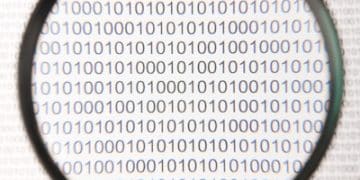Blockchain and Cybersecurity: Protecting US Data Against Breaches

Blockchain and cybersecurity converge to offer robust protection against data breaches and cyberattacks in the US, leveraging blockchain’s inherent security features to enhance data integrity and resilience.
In an era dominated by digital data, the importance of robust cybersecurity measures cannot be overstated. The intersection of blockchain and cybersecurity: protecting against data breaches and cyberattacks in the US, provides innovative solutions to safeguard sensitive information and critical infrastructure. This article explores the transformative potential of blockchain technology in enhancing cybersecurity, addressing key vulnerabilities, and ensuring data integrity.
Understanding the Basics of Blockchain Technology
Blockchain technology, initially conceived as the backbone of cryptocurrencies like Bitcoin, has evolved into a versatile tool with applications far beyond digital currencies. Its fundamental principles offer unique advantages for enhancing cybersecurity measures.
At its core, a blockchain is a decentralized, distributed, and immutable ledger that records transactions across many computers. This structure inherently provides a high level of security.
Key Principles of Blockchain
Understanding the core principles of blockchain is essential to appreciating its potential in cybersecurity.
- Decentralization: Data is distributed across a network, reducing the risk of single points of failure.
- Immutability: Once a transaction is recorded, it cannot be altered or deleted, ensuring data integrity.
- Transparency: All participants can view the transaction history, promoting accountability and trust.
- Cryptography: Advanced cryptographic techniques secure transactions and control the creation of new blocks.
These principles make blockchain an attractive option for securing data and protecting against cyber threats.
The inherent security features of blockchain, such as cryptographic hashing and consensus mechanisms, play a critical role in preventing unauthorized access and data manipulation. This foundational understanding is crucial for leveraging blockchain in cybersecurity applications.
The Cybersecurity Landscape in the US
The United States faces a complex and evolving cybersecurity landscape, with threats ranging from individual hackers to sophisticated state-sponsored attacks. Understanding the nature and scope of these threats is vital for developing effective defense strategies.
Data breaches, ransomware attacks, and cyber espionage are increasingly common, impacting businesses, government agencies, and critical infrastructure across the nation.

Common Cyber Threats in the US
Several types of cyber threats pose significant risks to US organizations and individuals.
- Data Breaches: Unauthorized access and theft of sensitive data, often resulting in financial loss and reputational damage.
- Ransomware Attacks: Malicious software that encrypts data and demands a ransom for its release, disrupting operations and causing financial strain.
- Phishing Scams: Deceptive emails and websites that trick users into revealing personal information, leading to identity theft and fraud.
- Distributed Denial-of-Service (DDoS) Attacks: Overwhelming a system with traffic to render it unusable, disrupting services and causing downtime.
Effectively addressing these threats requires a multifaceted approach, incorporating both traditional cybersecurity measures and innovative solutions like blockchain. As cyber threats become more sophisticated, the need for advanced security measures increases.
The increasing frequency and sophistication of cyberattacks underscore the need for innovative solutions that can enhance data protection and resilience. Blockchain technology offers a promising avenue for strengthening cybersecurity defenses in the United States.
How Blockchain Enhances Cybersecurity
Blockchain technology offers several key advantages for enhancing cybersecurity, including improved data integrity, enhanced authentication, and decentralized access control.
By leveraging blockchain’s unique features, organizations can strengthen their defenses against various cyber threats and protect sensitive data more effectively.
Improved Data Integrity
Blockchain’s immutable ledger ensures that data remains tamper-proof and verifiable.
Each transaction is recorded in a block, which is linked to the previous block using cryptographic hashes. Any attempt to alter a transaction would change the hash, invalidating all subsequent blocks and making the tampering immediately detectable. This ensures data integrity and prevents unauthorized modifications.
Enhanced Authentication
Blockchain can be used to create secure and decentralized identity management systems.
By storing digital identities on a blockchain, individuals can control their personal information and grant access to services in a secure and transparent manner. This reduces the risk of identity theft and phishing attacks, enhancing overall security.
Decentralized Access Control
Blockchain enables fine-grained access control policies that can enhance data privacy.
Traditional access control systems are often centralized, making them vulnerable to attack. By using blockchain, organizations can distribute access control across multiple nodes, reducing the risk of unauthorized access and data breaches. Smart contracts can also automate access control policies, ensuring that only authorized users can access sensitive data.
The combination of these features makes blockchain a powerful tool for enhancing cybersecurity and protecting against a wide range of threats. By implementing blockchain-based security solutions, organizations can significantly improve their security posture.
Use Cases of Blockchain in Cybersecurity
Blockchain technology is being applied in a variety of cybersecurity use cases, ranging from securing IoT devices to protecting supply chains.
These applications demonstrate the versatility and potential of blockchain in addressing specific cybersecurity challenges.

Securing IoT Devices
Blockchain can enhance the security of Internet of Things (IoT) devices by providing a decentralized and secure communication platform.
- Device Authentication: Blockchain can verify the identity of IoT devices, preventing unauthorized devices from accessing the network.
- Data Integrity: Blockchain can ensure that data transmitted by IoT devices is tamper-proof and reliable.
- Secure Updates: Blockchain can facilitate secure and authenticated software updates for IoT devices, preventing malware infections.
By leveraging blockchain, organizations can enhance the security and reliability of their IoT deployments.
Protecting Supply Chains
Blockchain can improve the transparency and security of supply chains by providing an immutable record of product provenance.
- Traceability: Blockchain can track products from origin to delivery, ensuring authenticity and preventing counterfeiting.
- Transparency: Blockchain provides a transparent view of the supply chain, allowing stakeholders to verify the integrity of products and processes.
- Security: Blockchain can prevent tampering and fraud by providing a secure and verifiable record of each transaction in the supply chain.
By implementing blockchain-based supply chain solutions, organizations can enhance trust and accountability in their supply chains.
Enhancing Data Storage
Blockchain technology may be used to ensure data is securely stored and protected from vulnerabilities.
- Encryption: Blockchain ensures data is encrypted and protected from unauthorized access, reducing the risk of data breaches.
- Accessibility: Blockchain makes data easily accessible as needed, ensuring an efficient operation for organizations.
- Tamper-proof: Using blockchain provides a transparent view of the supply chain, allowing stakeholders to verify the integrity of data.
Blockchain enhances cybersecurity across various sectors, offering solutions to protect sensitive data.
These use cases demonstrate the wide range of applications for blockchain in cybersecurity and its potential to address critical security challenges across various industries. As blockchain technology continues to mature, its adoption in cybersecurity is expected to grow.
Challenges and Limitations of Blockchain in Cybersecurity
Despite its many advantages, blockchain technology also faces certain challenges and limitations when applied to cybersecurity.
Understanding these limitations is crucial for assessing the suitability of blockchain for specific cybersecurity applications.
Scalability Issues
Blockchain networks can be slow and inefficient, limiting their ability to handle large volumes of transactions.
The consensus mechanisms used by many blockchain networks require significant computational resources and time, which can slow down transaction processing. This limitation can be a barrier to adoption in high-throughput environments.
Regulatory Uncertainty
The regulatory landscape for blockchain technology is still evolving, creating uncertainty for businesses considering its adoption.
Many jurisdictions have not yet established clear legal frameworks for blockchain, which can deter organizations from investing in blockchain-based solutions. Regulatory uncertainty can also create compliance challenges and increase the risk of legal disputes.
Complexity
Integrating blockchain technology with existing cybersecurity systems can be complex and challenging.
Blockchain requires specialized expertise and infrastructure, which can be difficult for organizations to acquire. Integrating blockchain with legacy systems can also be complex and costly. Careful planning and execution are essential for successful blockchain implementations.
Although blockchain technology offers great security features, there are limitations that need to be considered. By addressing these challenges, organizations can leverage blockchain to enhance their cyber security while mitigating potential risks.
Future Trends in Blockchain and Cybersecurity
The intersection of blockchain and cybersecurity is poised for significant growth and innovation in the coming years.
Several emerging trends are expected to shape the future of blockchain-based cybersecurity solutions, offering new opportunities for enhancing data protection and resilience.
Increased Adoption of Blockchain-as-a-Service (BaaS)
BaaS platforms can simplify the development and deployment of blockchain applications.
- Cost Savings: BaaS providers offer scalable and cost-effective infrastructure, reducing the upfront investment required for blockchain deployments.
- Faster Development: BaaS platforms provide pre-built tools and services, accelerating the development and deployment of blockchain applications.
- Enhanced Security: BaaS providers offer security services such as key management and vulnerability scanning, improving the overall security of blockchain applications.
As BaaS becomes more widely available, adoption of blockchain-based cybersecurity solutions is expected to increase.
Integration with AI and Machine Learning
Integrating blockchain with AI and machine learning can enhance threat detection and response capabilities.
- Anomaly Detection: AI and machine learning algorithms can analyze blockchain data to identify anomalous transactions and potential security threats.
- Automated Response: AI can automate incident response based on blockchain data, reducing the time required to mitigate cyberattacks.
- Predictive Security: AI can predict future security threats based on blockchain data, enabling proactive security measures.
The combination of AI and blockchain can create more intelligent and resilient cybersecurity systems.
Quantum-Resistant Cryptography
As quantum computing technology advances, the need for quantum-resistant cryptography becomes increasingly important.
Quantum computers have the potential to break many of the cryptographic algorithms used in current blockchain networks. Developing and implementing quantum-resistant cryptographic algorithms is essential to ensuring the long-term security of blockchain-based systems.
As technology continues to advance, blockchain and cyber security will continue to grow, providing new opportunities to enhance data protection and resistance.
| Key Point | Brief Description |
|---|---|
| 🛡️ Data Integrity | Blockchain ensures data is tamper-proof and verifiable, enhancing security. |
| 🔑 Authentication | Decentralized identity management reduces identity theft and phishing risks. |
| 🌐 Supply Chain | Blockchain enhances transparency and security, tracking products from origin to delivery. |
| 🤖 AI Integration | AI and blockchain together improve threat detection and offer predictive security. |
Frequently Asked Questions
▼
Blockchain is a decentralized, distributed digital ledger consisting of blocks that store transaction data. Each block is linked to the previous one using cryptography, ensuring immutability. This structure enhances data security and transparency.
▼
Blockchain enhances data integrity through its immutable nature. Once data is recorded in a block, it cannot be altered or deleted. This feature ensures that the data remains tamper-proof, providing a high level of assurance in the data’s accuracy.
▼
Cybersecurity threats in the US include data breaches, ransomware attacks, phishing scams, and distributed denial-of-service (DDoS) attacks. These threats can disrupt operations, compromise sensitive data, and result in financial or reputational damage.
▼
Blockchain can secure IoT devices by providing a decentralized and secure communication platform, verifying the identity of devices, ensuring data integrity, and facilitating secure software updates. This enhances the overall security and reliability of IoT deployments.
▼
Future trends include increased adoption of Blockchain-as-a-Service (BaaS), integration with AI and machine learning, and the development of quantum-resistant cryptography. These advances will enhance threat detection and response capabilities.
Conclusion
In conclusion, the synergy between **blockchain and cybersecurity: protecting against data breaches and cyberattacks in the US** represents a significant advancement in the efforts to safeguard digital assets and infrastructure. As blockchain technology continues to evolve, its innovative applications will undoubtedly fortify the nation’s defenses against increasingly sophisticated cyber threats.





